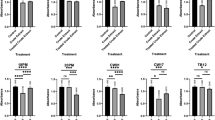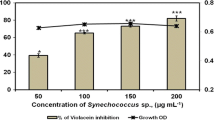Abstract
China remains by far the largest aquaculture producer in the world. However, biofilms formed by pathogenic Vibrio strains pose serious problems to marine aquaculture. To provide a strategy for biofilm prevention, control, and eradication, extracts from 88 marine actinomycetes were screened. Thirty-five inhibited the biofilm formation of Vibrio harveyi, Vibrio vulnificus, and Vibrio anguillarum at a concentration of 2.5% (v/v). Thirty-three of the actinomycete extracts dispersed the mature biofilm. Six extracts inhibited the quorum-sensing system of V. harveyi by attenuating the signal molecules N-acylated homoserine lactones’ activity. Strain A66, which was identified as Steptomyces albus, both attenuated the biofilms and inhibited their quorum-sensing system. It is suggested that strain A66 is a promising candidate to be used in future marine aquaculture.






Similar content being viewed by others
References
Austin B, Zhang XH (2006) Vibrio harveyi: a significant pathogen of marine vertebrates and invertebrates. Lett Appl Microbiol 43:119–124
Barcina I, Iriberry J, Egea L (1987) Enumeration, isolation and some physiological properties of actinomycetes from sea water and sediment. Syst Appl Microbiol 10:85–91
Bomchil N, Watnick P, Kolter R (2003) Identification and characterization of a Vibrio cholerae gene, mbaA, involved in maintenance of biofilm architecture. J Bacteriol 185:1384–1390
Brooun A, Liu S, Lewis K (2000) A dose-response study of antibiotic resistance in Pseudomonas aeruginosa biofilms. Antimicrob Agents Chemother 44:640–646
Davey ME, O’Toole GA (2000) Microbial biofilms: from ecology to molecular genetics. Microbiol Mol Biol Rev 64:847–867
Defoirdt T, Crab R, Wood TK, Sorgeloos P, Verstraete W, Bossier P (2006) Quorum sensing-disrupting brominated furanones protect the gnotobiotic brine shrimp Artemia franciscana from pathogenic Vibrio harveyi, Vibrio campbellii, and Vibrio parahaemolyticus isolates. Appl Environ Microbiol 72:6419–6423
Dong B, Xiang JH, Yang M, Wang JY, Liu G (2003) The basic study of the disease and in marine aquaculture. Chin Bas Sci 6:19–24
FAO (Food and Agriculture Organization of the United Nations) (2005) The State of World Fisheries and Aquaculture 2004. Part 1. World review of fisheries and aquaculture, food and agriculture organization of the United Nations. Aqua KE Gov Doc 2005:8010210
Faruque SM, Biswas K, Udden SMN, Ahmad QS, Sack DA, Nair GB, Mekalanos JJ (2006) Transmissibility of cholera: in vivo-formed biofilms and their relationship to infectivity and persistence in the environment. Proc Natl Acad Sci USA 103:6350–6355
Felsenstein J (1993) PHYLIP (Phylogenetic Inference Package), version 3.5c. Distributed by the author. Department of Genetics, University of Washington, Seattle, WA
Hammer BK, Bassler BL (2003) Quorum sensing controls biofilm formation in Vibrio cholerae. Mol Microbiol 50:101–114
Hentzer M, Wu H, Andersen JB, Riedel K, Rasmussen TB, Bagge N, Kumar N, Schembri MA, Song Z, Kristoffersen P, Manefield M, Costerton JW, Molin S, Eberl L, Steinberg P, Kjelleberg S, Hoiby N, Givskov M (2003) Attenuation of Pseudomonas aeruginosa virulence by quorum sensing inhibitors. EMBO J 22:3803–3815
Karunasagar I, Pai R, Malathi GR, Karunasagar I (1994) Mass mortality of Penaeus monodon larvae due to antibiotic-resistant Vibrio harveyi infection. Aquaculture 128:203–209
Karunasagar I, Otta SK, Karunasagar I (1996) Biofilm formation by Vibrio harveyi on surface. Aquaculture 140:241–245
Kimura M (1980) A simple method for estimating evolutionary rates of base substitutions through comparative studies of nucleotide sequences. J Mol Evol 16:111–120
Kierek K, Watnick PI (2003) Environmental determinants of Vibrio cholerae biofilm development. Environ Microbiol 69:5079–5088
O’Toole GA, Pratt LA, Watnick PI, Newman DK, Weaver VB, Kolter R (1999) Genetic approaches to study of biofilms. Methods Enzymol 310:91–109
Petit A, Tempe J (1978) Isolation of Agrobacterium Ti plasmid regulatory mutants. Mol Gen Genet 167:147–155
Pratt LA, Kolter R (1998) Genetic analysis of Escherichia coli biofilm formation: roles of flagella, motility, chemotaxis and type I pili. Mol Microbiol 30:285–293
Ren D, Sims JJ, Wood TK (2001) Inhibition of biofilm formation and swarming of Escherichia coli by (5Z)4-bromo-5-(bromomethylene)-3-butyl-2(5H)-furanone. Environ Microbiol 3:731–736
Saitou N, Nei M (1987) The neighbor-joining method: a new method for reconstructing phylogenetic trees. Mol Biol Evol 4:406–425
Schembri MA, Givskov M, Klemm P (2002) An attractive surface: gram-negative bacterial biofilms. Sci STKE 132:RE6
Shi W, Sun H (2002) Type IV pilus-dependent motility and its possible role in bacterial. Pathogenesis 70:1–4
Thomas BR, Mette ES, Thomas B, Richard KP, Kathrine BC (2005) Identity and effects of quorum-sensing inhibitors produced by Penicillium species. Microbiology 151:1325–1340
Thompson JD, Gibson TJ, Plewniak F, Jeanmougin F, Higgins DG (1997) The CLUSTAL_X Windows interface: flexible strategies for multiple sequence alignment aided by quality analysis tools. Nucleic Acids Res 25:4876–4882
Tinh NTN, Linh ND, Wood TK, Dierckens K, Sorgeloos P, Bossier P (2006) Interference with the quorum sensing systems in a Vibrio harveyi strain alters the growth rate of gnotobiotically cultured rotifer Brachionus plicatilis. J Appl Microbiol 103:194–203
Wai SN, Mizunoe Y, Takade A, Kawabata SI, Yoshida SI (1998) Vibrio cholerae O1 Strain TSI-4 produces the exopolysaccharide materials that determine colony morphology, stress resistance, and biofilm formation. Appl Environ Microbiol 64:3648–3655
Wang SY, Lauritz J, Jass J, Milton DL (2003) Role for the major outer-membrane protein from Vibrio anguillarum in bile resistance and biofilm formation. Microbiology 149:1061–1071
Waters CM, Bassler BL (2006) The Vibrio harveyi quorum-sensing system uses shared regulatory components to discriminate between multiple autoinducers. Genes Dev 20:2754–2767
Watnick PI, Kolter R (1999) Steps in the development of a Vibrio cholerae El Tor biofilm. Mol Microbiol 34:586–595
Watnick PI, Lauriano CM, Klose KE, Croal L, Kolter R (2001) The absence of a flagellum leads to altered colony morphology, biofilm development and virulence in Vibrio cholerae O139. Mol Microbiol 39:223–235
Wong HC, Chung YC, Yu JA (2002) Attachment and inactivation of Vibrio parahaemolyticus on stainless steel and glass surface. Food Microbiol 19:341–350
Wu W, Hu CQ, Tao BH (2001) Studies on pathogenetic biology of vibriosis occurring in Penaeus monodon. J Trop Oceanogr 20:80–87
Yildiz FH, Schoolnik GK (1999) Vibrio cholerae 01 El Tor: identification of a gene cluster required for the rugose colony type, exopolysaccharide production, chlorine resistance, and biofilm formation. Proc Natl Acad Sci USA 96:4028–4033
You JL, Cao LX, Liu GF, Zhou SN, Tan HM, Lin YC (2005) Isolation and characterization of actinomycetes antagonistic to pathogenic Vibrio spp. from nearshore marine sediments. World J Microbiol Biotechnol 21:679–682
Zhang L, An R, Wang J, Sun N, Zhang S, Hu J, Kuai J (2005) Isolation of novel bioactive compounds from marine microbes. Curr Opin Microbiol 8:276–281
Zhang L, Yan K, Zhang Y, Bian J, Zheng C, Sun H, Chen Z, Sun N, Song Y, Zhuo Y, You J et al (2007) High-throughput synergy screening identifies microbial metabolites as combination agents for the treatment of fungal infections. Proc Natl Acad Sci USA 104:4606–4611
Zhu J, MeKalanos JJ (2003) Quorum sensing-dependent biofilms enhance colonization in Vibrio cholerae. Dev Cell 5:647–656
Zhu J, Beaber JW, Moré MI, Clay FQ, Eberhard A, Winans SC (1998) Analogs of the autoinducer 3-oxooctanoyl-homoserine lactone strongly inhibit activity of the TraR protein of Agrobacterium tumefaciens. J Bacteriol 180:5398–5405
Zhu J, Chai Y, Zhong Z, Li S, Winans SC (2003) Agrobacterium bioassay strain for ultrasensitive detection of N-acylhomoserine lactone-type quorum-sensing molecules: detection of autoinducers in Mesorhizobium huakuii. Appl Environ Microbiol 69:6949–6953
Acknowledgment
We thank Arnold Demain for his critical reading of the manuscript and helpful discussions. This work was supported by grants from the National High Technology Research and Development Plan of China 2003AA620401, 863 project 2006AA09Z402, Chinese Academy of Sciences Innovation Projects O62A131BB4, 973 project 2007CB707802, and pilot grants from the South China Sea Institute of Oceanology, Chinese Academy of Sciences.
Author information
Authors and Affiliations
Corresponding author
Rights and permissions
About this article
Cite this article
You, J., Xue, X., Cao, L. et al. Inhibition of Vibrio biofilm formation by a marine actinomycete strain A66. Appl Microbiol Biotechnol 76, 1137–1144 (2007). https://doi.org/10.1007/s00253-007-1074-x
Received:
Revised:
Accepted:
Published:
Issue Date:
DOI: https://doi.org/10.1007/s00253-007-1074-x




